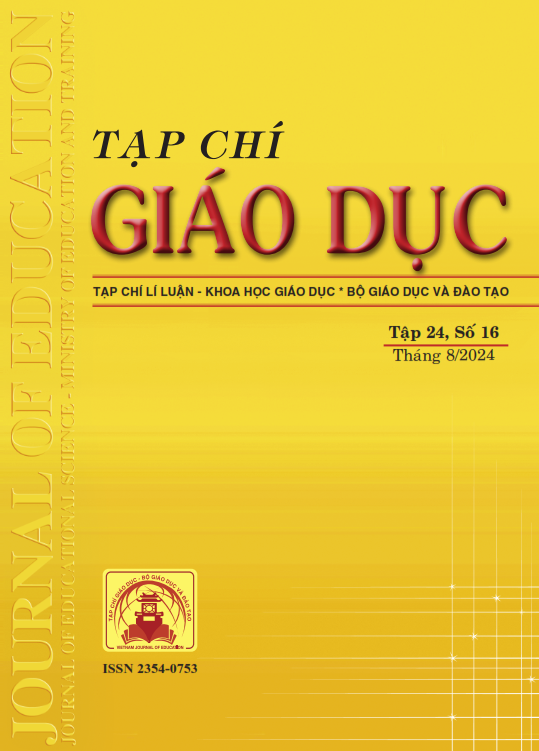Kĩ năng tư duy phản biện của trẻ 5-6 tuổi: Một nghiên cứu tổng quan
Tóm tắt
Critical thinking skills are one of the basic thinking operations and qualities, helping 5-6 year old preschool children express their thoughts and assessment of objects and phenomena, develop the ability to reason, recognize, analyze, evaluate arguments, process information from diverse sources, make quality judgments and solve problems. The article uses theoretical research methods to collect, analyze, synthesize, systematize, and generalize scientific documents on critical thinking skills of 5-6 year old children, with 5 contents: concepts, characteristics of children's critical thinking skills; the role of critical thinking skills in children's cognitive activities; content and methods of educating critical thinking skills for children; factors affecting the education of critical thinking skills for 5-6 year old children. The research results provide an overview of critical thinking skills and methods for developing these skills for 5-6 year old children, and at the same time highlight the necessity of researching and developing critical thinking skills for children in more in-depth areas.
Tài liệu tham khảo
Alkın, S. S., & Tunca, N. (2015). Felsefe ve eleştirel düşünme. Trakya Üniversitesi Eğitim Fakültesi Dergisi, 5(2), 192-206.
Asmawati, L. (2014). Perencanaan pembelajaran PAUD. Remaja Rosdakarya.
Bailin, S., Case, R., Cooms, J. R., & Daniels, L. B. (1999). Common misconceptions of critical thinking. Journal of Curriculum Studies, 31(3), 269-283.
Baillargeon, N. (2016). Aklın ve bilimin ışığında eleştirel düşünme kılavuzu. Ankara: Dipnot.
Berk, L. E. (2013). Çocuk gelişimi (B. Onur. ve A. Dönmez, Çev.). Ankara: İmge.
Beyer, B. K. (1988). Developing a scope and sequence for thinking skills instruction. Educational Leadership, 45(5), 26-30.
Bộ GD-ĐT (2010). Quy định về bộ chuẩn phát triển trẻ em năm tuổi (ban hành kèm theo Thông tư số 23/2010/TT-BGDĐT ngày 23/7/2010 của Bộ trưởng Bộ GD-ĐT).
Bredekamp, S. (2015). Erken çocukluk eğitiminde etkili uygulamalar. Z. İnan & T. İnan (Ed.), Kültürel ve dilsel farklılıkları benimseme (Z. Öztürk, Çev.) içinde (s. 170- 203). Ankara: Nobel.
Chantal, P. L., & Markovits, H. (2017). The capacity to generate alternative ideas is more important than inhibition for logical reasoning in preschool-age children. Memory & Cognition, 45(2), 208-220.
Daniel, M., & Gagnon, M. (2012). Pupıls’ age and philosophical praxis: two factors that influence the development of critical thınking in children. Childhood & Philosophy, 8(15), 115-142.
Đinh Thị Quỳnh Hà (2023). Phát triển tư duy phản biện cho sinh viên trong giai đoạn hiện nay. Hội thảo Quốc gia “Lao động, việc làm và an sinh xã hội ở Việt Nam”, Trường Đại học Ngoại thương, tr 366-374.
Epstein, A. S. (2013). Helping Preschoolers Build Their Thinking Skills. Teaching Young Children, 7(1), 20-23.
Facione, P. (1990). Critical Thinking: A Statement of Expert Consensus for Purposes of Educational Assessment and Instruction, Research Findings and Recommendations. American Philosophical Association, Newark, Del.
Gray, A. (2016). The 10 skills you need to thrive in the Fourth Industrial Revolution. https://www.weforum.org/ agenda/2016/01/the-10-skills-you-need-to-thrive-in-thefourth-industrial-revolution/
Heyman, G. D. (2008). Children's critical thinking when learning from others. Current Directions in Psychological Science, 17(5), 344-347.
Johnson, A. P. (2000).Up and out: Using creative and critical thinking skills to enhance learning. Boston: Ally & Bacon.
Kazi, M. R., Chowdhury, N., Chowdhury, M. M., & Turin, T. C. (2021). Conducting a rapid review for quick turnaround knowledge synthesis. Health Primary Care, 5, 1-7.
Kuswana, W. S. (2011). Taksonomi berpikir. Bandung: PT Remaja Rosdakarya.
Kim, S. J. (2016). Expanding the Horizons for Critical Literacy in a Bilingual Preschool Classroom: Children’sResponses in Discussions with Gender-Themed Picture Books. International Journal of Early Childhood, 48(3), 311-327.
Lai, E. R. (2011). Critical thinking: A literature review. Pearson's Research Reports, 6(1), 40-41.
León, J. M. (2015). A baseline study of strategies to promote critical thinking in the preschool classroom. GIST Education And Learning Research Journal, 10, 113-127.
Lipman, M. (1988). Critical thinking -What can it be? Educational Leadership, 46(1), 38-43.
Nguyễn Ánh Tuyết (2013). Giáo trình sự phát triển tâm lí trẻ em lứa tuổi mầm non. NXB Giáo dục Việt Nam.
Nguyễn Thị Nga (2018). Phát triển tư duy phản biện cho học sinh trong mô hình trường học thông minh. Kỉ yếu hội thảo quốc tế “Giáo dục cho mọi người” (Proceedings of international conference “Education for all”). NXB Đại học Quốc gia Hà Nội, tr 34-42.
Santín, M. F., & Torruella, M. F. (2017).Reggio Emilia: An essential tool to develop critical thinking in early childhood. Journal of New Approaches in Educational Research, 6(1), 50-56. http://doi.org/10.7821/naer.2017.1.207
Smetanová, V., Drbalová, A., & Dáša, V. (2015). Implicit theories of reflective thinking in teachers and future teachers. Department Social and Behavioral Studies, 171, 724-732. https://doi.org/10.1016/j.sbspro.2015
Trần Thị Ngọc Trâm (2003). Thiết kế và sử dụng trò chơi học tập nhằm phát triển khả năng khái quát hoá của trẻ mẫu giáo lớn (5-6 tuổi). Luận án tiến sĩ Giáo dục học, Viện Chiến lược và Chương trình Giáo dục.
Yaralı, K. T., & Aytar, F. A. G. (2018). Eleştirel düşünme perspektifinden okul öncesi eğitim programı, V. Uluslarası Avrasya Eğitim Bilimleri Kongresi’nde sunulmuş bildiri, Akdeniz Üniversitesi, Antalya.
Yulianti, D. (2010). Bermain sambal belajar sains di taman kanakkanak. Jakarta: PT Indeks.
Zohar, A.,& Dori, Y. J. (2003).Higher order thinking skills and low-achieving students: Are they mutually exclusive. The Journal of Learning Sciences, 12(2), 145-181.
Tải xuống
Đã Xuất bản
Cách trích dẫn
Số
Chuyên mục
Giấy phép

Tác phẩm này được cấp phép theo Ghi nhận tác giả của Creative Commons Giấy phép quốc tế 4.0 .












